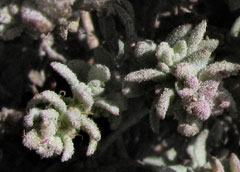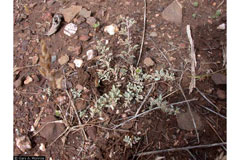 |
|
http://commons.wikimedia.org/wiki/User:Stickpen |
 |
| Gary A. Monroe @ USDA-NRCS PLANTS Database |
Translate this page:
Summary
A. californica Moq. is a synonym of Extriplex californica. Formerly, it was included in genus Atriplex.
Physical Characteristics

 Atriplex californica is a PERENNIAL growing to 0.1 m (0ft 4in) at a medium rate.
Atriplex californica is a PERENNIAL growing to 0.1 m (0ft 4in) at a medium rate.
See above for USDA hardiness. It is hardy to UK zone 8. It is in flower from July to August, and the seeds ripen from August to October. The species is monoecious (individual flowers are either male or female, but both sexes can be found on the same plant) and is pollinated by Wind. The plant is self-fertile.
It is noted for attracting wildlife.
Suitable for: light (sandy) and medium (loamy) soils, prefers well-drained soil and can grow in nutritionally poor soil. Suitable pH: mildly acid, neutral and basic (mildly alkaline) soils and can grow in very alkaline and saline soils.
It cannot grow in the shade. It prefers dry or moist soil and can tolerate drought. The plant can tolerate maritime exposure.
UK Hardiness Map
US Hardiness Map
Synonyms
A. californica Moq. is a synonym of Extriplex californica
Plant Habitats
Cultivated Beds;
Edible Uses
Edible Parts: Leaves Seed
Edible Uses:
Leaves - cooked. Seed - cooked. Used as a piñole[103, 105, 161, 177]. The seeds are 1 - 2mm in diameter[270].
References More on Edible Uses
Medicinal Uses
Plants For A Future can not take any responsibility for any adverse effects from the use of plants. Always seek advice from a professional before using a plant medicinally.
None known
References More on Medicinal Uses
The Bookshop: Edible Plant Books
Our Latest books on Perennial Plants For Food Forests and Permaculture Gardens in paperback or digital formats.

Edible Tropical Plants
Food Forest Plants for Hotter Conditions: 250+ Plants For Tropical Food Forests & Permaculture Gardens.
More

Edible Temperate Plants
Plants for Your Food Forest: 500 Plants for Temperate Food Forests & Permaculture Gardens.
More

More Books
PFAF have eight books available in paperback and digital formats. Browse the shop for more information.
Shop Now
Other Uses
Saltbush is often used for erosion control, as a windbreak, and for soil stabilization. Its high salt tolerance makes it suitable for saline soils, and it can be used as forage for livestock.
1. Nectary - Flowers rich in nectar and pollen:
No – Saltbush is wind-pollinated, so it doesn’t produce nectar-rich flowers to attract pollinators.
2. Wildlife - Food (Fruit, Seeds, Leaf litter, Shelter, Nesting, Roosting):
Yes – Saltbush provides food for wildlife through its seeds and foliage. It is an important food source for herbivores like birds and small mammals. The dense, bushy form also provides shelter and cover for nesting birds and other small animals.
3. Invertebrate Shelter (Overwintering sites, Leaf litter, Groundcover):
Yes – The dense, shrubby growth of Saltbush offers good ground cover for invertebrates, and the fallen leaves can serve as shelter and overwintering sites for beneficial insects.
4. Pest Confuser (Smell):
No – Saltbush does not have a strong aromatic smell that repels pests, so it is not typically used as a pest confuser.
Special Uses
References More on Other Uses
Cultivation details
Succeeds in full sun in any well-drained but not too fertile soil[200]. Most species in this genus tolerate saline and very alkaline soils[200]. Succeeds in a hot dry position. This species is not hardy in the colder areas of the country, it tolerates temperatures down to between -5 and -10°c[200]. Saltbush can be harvested for forage throughout the growing season, typically in late spring to early autumn.
Saltbush generally flowers in late summer to early autumn, depending on the specific species and growing conditions.
Saltbush species are typically slow to moderate in growth, depending on the environmental conditions, but can establish well in poor soils. The plant may be monoecious or dioecious, with some plants having both male and female flower types, and others having just one.
References Carbon Farming Information and Carbon Sequestration Information
Temperature Converter
Type a value in the Celsius field to convert the value to Fahrenheit:
Fahrenheit:
The PFAF Bookshop
Plants For A Future have a number of books available in paperback and digital form. Book titles include Edible Plants, Edible Perennials, Edible Trees,Edible Shrubs, Woodland Gardening, and Temperate Food Forest Plants. Our new book is Food Forest Plants For Hotter Conditions (Tropical and Sub-Tropical).
Shop Now
Plant Propagation
Seed - sow April/May in a cold frame. Germination usually takes place within 1 - 3 weeks at 13°c. As soon as they are large enough to handle, prick the seedlings out into individual pots and plant them out into their permanent positions in the summer[134].
Other Names
If available other names are mentioned here
Extriplex californica. California saltbush or California orache.
Native Range
Native to: California, Mexico Northwest
Weed Potential
Right plant wrong place. We are currently updating this section.
Please note that a plant may be invasive in one area but may not in your area so it's worth checking.
Conservation Status
IUCN Red List of Threatened Plants Status :

| Related Plants
|
| Latin Name | Common Name | Habit | Height | Hardiness | Growth | Soil | Shade | Moisture | Edible | Medicinal | Other |
| Atriplex argentea | Silvery Orach, Silverscale saltbush, Stalked saltbush | Annual | 0.5 |
4-9
| | LM | N | M | 3 | 2 | 2 |
| Atriplex argentea expansa | Silverscale Saltbush | Annual | 0.6 |
-
| | LM | N | M | 2 | 0 | |
| Atriplex canescens | Grey Sage Brush, Fourwing saltbush | Shrub | 1.8 |
3-9
| M | LM | N | DM | 3 | 1 | 3 |
| Atriplex carnosa | Thickleaf Orach | Annual | 0.9 |
-
| | LM | N | DM | 2 | 0 | |
| Atriplex cinerea | Grey Saltbush | Shrub | 2.0 |
9-11
| M | LM | N | DM | 3 | 0 | 3 |
| Atriplex confertifolia | Shadscale, Shadscale saltbush | Shrub | 1.5 |
4-9
| M | LM | N | DM | 3 | 1 | 2 |
| Atriplex coronata | Crownscale | Annual | 0.4 |
-
| | LM | N | DM | 2 | 0 | |
| Atriplex dimorphostegia | | Annual | 0.2 |
-
| | LM | N | DM | 2 | 0 | |
| Atriplex elegans | Wheelscale Saltbush | Annual | 0.2 |
0-0
| | LM | N | DM | 3 | 0 | 1 |
| Atriplex glabriuscula | Scotland orache, Maritime saltbush, Frankton's saltbush, Northeastern saltbush | Annual | 0.3 |
0-0
| | LM | N | DM | 2 | 0 | |
| Atriplex gmelinii | Gmelin's saltbush | Annual | 0.5 |
0-0
| | LM | N | DM | 2 | 0 | |
| Atriplex halimus | Sea Orach, Saltbush | Shrub | 2.0 |
7-10
| M | LM | N | DM | 5 | 1 | 3 |
| Atriplex hastata | Hastate Orach | Annual | 0.8 |
0-0
| | LM | N | DM | 3 | 0 | 2 |
| Atriplex hortensis | Orach, Garden orache | Annual | 1.8 |
5-9
| F | LM | N | M | 4 | 2 | 3 |
| Atriplex lapathifolia | | Annual | 0.9 |
-
| | LM | N | DM | 3 | 0 | |
| Atriplex lentiformis | Quail Bush, Big saltbush, Quailbush, | Shrub | 3.0 |
8-11
| M | LM | N | DM | 2 | 1 | 3 |
| Atriplex littoralis | Grassleaf orache | Biennial | 0.7 |
4-11
| F | LMH | N | DM | 2 | 0 | 0 |
| Atriplex maximowicziana | Maximowicz's saltbush | Perennial | 0.8 |
0-0
| | LM | N | DM | 2 | 0 | |
| Atriplex mucronata | | Annual | 0.4 |
-
| | LMH | N | DM | 2 | 0 | |
| Atriplex nummularia | Giant Saltbush, Bluegreen saltbush | Shrub | 3.5 |
7-10
| M | LM | N | DM | 3 | 2 | 3 |
| Atriplex nuttallii | Nuttall's Saltbush | Shrub | 0.9 |
5-9
| M | LM | N | DM | 4 | 0 | 2 |
| Atriplex obovata | Mound Saltbrush | Shrub | 1.0 |
5-9
| M | LMH | N | DM | 3 | 0 | 3 |
| Atriplex patula | Spreading Orach, Spear saltbush | Annual | 0.8 |
0-0
| | LM | N | M | 3 | 1 | 0 |
| Atriplex polycarpa | Cattle spinach | Shrub | 1.0 |
8-10
| M | LM | N | DM | 1 | 0 | 4 |
| Atriplex powellii | Powell's Saltweed | Annual | 0.7 |
4-9
| | LM | N | DM | 3 | 0 | 2 |
| Atriplex rosea | Tumbling or redscale saltweed | Annual | 0.6 |
3-10
| F | LM | N | DM | 2 | 2 | 2 |
| Atriplex saccaria | Sack Saltbush | Annual | 0.3 |
5-9
| | LM | N | DM | 3 | 0 | 0 |
| Atriplex semibaccata | Australian Saltbush. Australian saltbush, Creeping saltbush | Shrub | 0.5 |
8-11
| F | LMH | N | DM | 3 | 0 | 3 |
| Atriplex serenana | Bractscale, Davidson's bractscale | Annual | 3.0 |
8-11
| | LM | N | DM | 3 | 0 | 0 |
|
|
Growth: S = slow M = medium F = fast. Soil: L = light (sandy) M = medium H = heavy (clay). pH: A = acid N = neutral B = basic (alkaline). Shade: F = full shade S = semi-shade N = no shade. Moisture: D = dry M = Moist We = wet Wa = water.
Now available:
Food Forest Plants for Mediterranean Conditions
350+ Perennial Plants For Mediterranean and Drier Food Forests and Permaculture Gardens.
[Paperback and eBook]
This is the third in Plants For A Future's series of plant guides for food forests tailored to
specific climate zones. Following volumes on temperate and tropical ecosystems, this book focuses
on species suited to Mediterranean conditions—regions with hot, dry summers and cool, wet winters,
often facing the added challenge of climate change.
Read More
Expert comment
Author
Moq.
Botanical References
71200270
Links / References
For a list of references used on this page please go here
Readers comment
| Add a comment |
|
If you have important information about this plant that may help other users please add a comment or link below. Only comments or links that are felt to be directly relevant to a plant will be included. If you think a comment/link or information contained on this page is inaccurate or misleading we would welcome your feedback at [email protected]. If you have questions about a plant please use the Forum on this website as we do not have the resources to answer questions ourselves.
* Please note: the comments by website users are not necessarily those held by PFAF and may give misleading or inaccurate information.
To leave a comment please Register or login here All comments need to be approved so will not appear immediately.
|
Subject : Atriplex californica
|
|
|
|